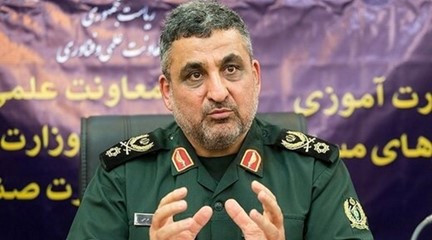
Brigadier-General Seyyed Mahdi Farahi.
“This year, the [Defense Industries] Organization has grown by 200 percent.”
Iran has steadily increased its defense budget following the 2015 Joint Comprehensive Plan of Action and the lifting of many United Nations sanctions.[i] According to the excerpted article from the Ministry of Defense’s Holy Defense News Agency, that windfall has now come to Iran’s Defense Industry Organization (DIO), the state-owned conglomerate meant to bolster the Iran’s indigenous military technology development and manufacturing base. In the excerpted article, Deputy Defense Minister Seyyed Mahdi Farahi, an Islamic Revolutionary Guard Corps (IRGC) general who previously headed Iran’s Aerospace Industries Organization and served as DIO managing director, reported that the DIO budget tripled from the previous year. DIO exports have reportedly more than doubled, suggesting that Iran has recouped some of the investment it made to develop the same weapons it deploys itself. Iran’s exports of drones to Russia likely comprises a large portion of these export revenues.[ii]
Iranian arms exports might also be bolstering IRGC coffers given that Farahi may funnel the proceeds of Iranian weapon sales to the IRGC. IRGC-run businesses seldom if ever return their profits to the central treasury, and the IRGC’s official budget allocation accounts for perhaps only a quarter of its actual funding. Farahi’s celebration of DIO may also reflect renewed investment in Iran’s nuclear and missile programs given that such public spotlight often coincides with an organization’s growing centrality to Iranian strategy. The DIO would be the paramount organization coordinating domestic manufacture of military hardware for these programs as Iran is loath to rely on external manufacturing for such high-profile hardware because of Iran’s vulnerability to sanctions. Both the European Union and the U.S. Treasury Department have sanctioned Farahi for his role in proliferating weapons of mass destruction and delivery systems, work which often saw Farahi travel to and negotiate with North Korea.[iii]
Source:
“Rashad 200 dar sadi sazman-e sanaya’-e defah nesbat beh sal gerefteh (Two Hundred Percent Growth in Defense Industry Organizations Over Past Year),” Holy Defense News Agency (official news agency of Iran’s Defense Ministry), 13 March 2023. https://defapress.ir/fa/news/578644
Explaining the favorable performance of the Defense Industries Organization in 2022-23, General Farahi said. “This year the Organization has grown by 200 percent over the previous year and has seen a 2.5 times growth in exports.”
The deputy minister of defense and support of the armed forces continued: “The organization also produced 57 new products from its research this year and after production, delivered these to the armed forces and even exported some of these products, which is very gratifying for the country’s defense industry….
Farahi said that behind these successes was the employment of some great intellects. “Maintaining and attracting efficient, committed and expert human resources is the beating heart of the organization and is one of the most important issues that should be considered by the managers of armed forces industries in order to advance the supreme goals of the organization.”
Notes:
[i] For previous discussion of the Iranian defense budget, see: Michael Rubin, “Iran: Budget Increases for Missiles, Qods Force,” OE Watch, 08-2017. https://community.apan.org/wg/tradoc-g2/fmso/m/oe-watch-past-issues/201732/download and Michael Rubin, “Iran: Military Budget Increased 145%,” OE Watch, 06-2017, https://community.apan.org/wg/tradoc-g2/fmso/m/oe-watch-past-issues/197269/download
[ii] Iran-Russia conversations regarding drone exports predate the current Ukraine war. See: Michael Rubin, “Iran: Russia Desperate for our UAV Technology,” OE Watch, 11-2016. https://community.apan.org/wg/tradoc-g2/fmso/m/oe-watch-past-issues/195245/download
[iii] For discussion of U.S. sanctions against Farahi, see: “Treasury Sanctions Those Involved in Ballistic Missile Procurement for Iran,” U.S. Department of Treasury, 17 January 2016. https://home.treasury.gov/news/press-releases/jl0322
Image Information:
Image: Brigadier-General Seyyed Mahdi Farahi
Source: https://image.alkawthartv.ir/imagema//original/2021/12/31/637765384943630275.jpg
Attribution: Al-Kawthar Television
